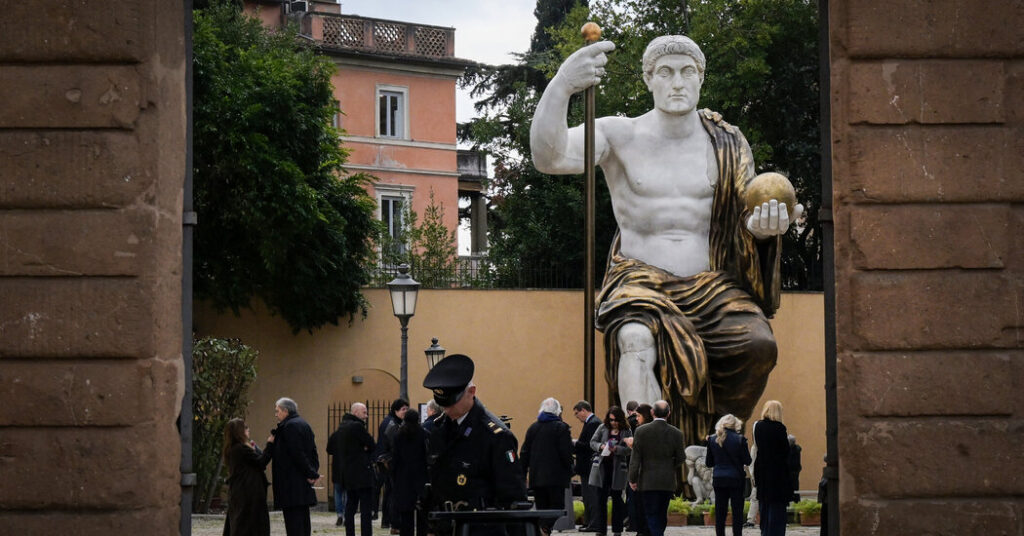It is probably not genuine, precisely, or very outdated in any respect.
But the colossal statue of a fourth-century emperor, Constantine the Great, is a newly erected monument to Rome if nothing else: a homage to the traditional metropolis’s grandeur, and of its limitless capability to remake itself.
In this case, the remaking was literal.
Towering over guests, the 43-foot seated statue was painstakingly reconstructed by a Madrid-based digital artwork group, Factum Foundation, from the ten recognized fragments of the unique sculpture. The reconstructed statue was put in in a backyard in Rome’s Capitoline Museums this week, near the place the Temple of Jupiter, an important temple of historic Rome, as soon as stood.
“Seeing Constantine, on top of the Capitoline Hill, looking out at the whole of Rome, he feels extraordinary,” stated Adam Lowe, the founding father of the Factum Foundation, which initially created the statue for a 2022 exhibit on the Prada Foundation in Milan.
The head and many of the different fragments of the colossal statue had been found in 1486, within the ruins of a constructing not removed from the Colosseum. They had been transferred to what finally turned the Capitoline assortment, and 9 of these historic fragments — together with a monumental head, toes and hand — are completely on present on the museums.
The fragments discovered fame from the second they had been excavated, stated Salvatore Settis, an archaeologist and one of many curators of the Prada exhibit. “They have been etched by leading artists from the 15th century on,” he stated, including that the sculpture additionally captured the eye of extra fashionable artists like Robert Rauschenberg, who famously photographed the items within the Nineteen Fifties.
Five hundred years and plenty of extra technological developments later, a workforce from the Factum Foundation spent three days utilizing photogrammetry, a 3D scan with a digicam, to document the fragments within the Capitoline courtyard. Over the course of a number of months, the high-resolution knowledge turned 3D prints, which had been used to solid replicas, product of acrylic resin and marble powder.
Those had been then built-in with different physique elements — those Constantine was lacking — that had been constructed after historic analysis and discussions with curators and consultants. A statue of the emperor Claudius because the god Jupiter, now on the historic Roman altar often known as the Ara Pacis, was used as a mannequin for the pose and draping, which was initially in bronze.
“It’s through the evidence of those fragments, working rather like forensic scientists, with all the experts from different disciplines, we were able to build back something that is absolutely awe inspiring,” Mr. Lowe stated, including that new applied sciences had been providing museums new avenues of analysis and dissemination.
“We’re not trying to build a fake object,” he added. “We’re trying to build something that physically and emotionally engages and that intellectually stimulates you.”
Recent scholarship on the statue has steered the statue of Constantine was itself reworked from an present colossus, presumably depicting Jupiter. Irrefutable indicators of remodeling are particularly current on the colossal statue’s face, in keeping with Claudio Parisi Presicce, Rome’s prime municipal artwork official, the director of the Capitoline Museums and an skilled on the colossus.
Indeed, some consultants hypothesize that the sculpture was initially the cult statue of a temple dedicated to Jupiter — the Temple of Jupiter Optimus Maximus — which might imply that the Constantine facsimile has lastly returned dwelling.
“We can’t be certain that it’s the same statue, but there is some possibility that it was,” Mr. Settis stated. Constantine, the primary emperor to transform to Christianity, could have particularly chosen a statue of Jupiter to remodel into an icon of himself. “That’s one hypothesis,” he stated. “It would mark a passage in Western Europe, from the pagan empire to a Christian one.”
The statue shall be on present within the Capitoline backyard till a minimum of the top of 2025, officers stated. Where it’s going to go afterward, and whether or not it’s going to face up to the ravages of time higher than its fractured unique, stay open questions.
But its creators a minimum of tried to make it sturdy.
“It’ll be as fine as anything is outside,” Mr. Lowe stated. “We hope. Of course, even during the opening there were pigeons sitting on its head. I’m afraid there’s not much you can do about that.”


